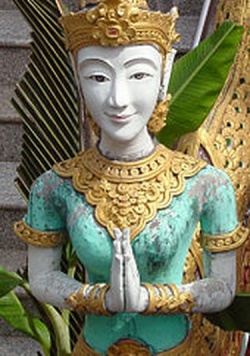What's a Mudrā?
Any tradition of religious art involves some means by which important scenes and figures can be recognized. For example, in western art, Christian saints are usually accompanied with objects connected in some way to their lives, which serve to identify them. For this reason, Saint Peter is shown holding a key. Saint Jerome, the translator of the Bible into Latin, is accompanied by his books and by a lion he tamed. And so on.
Nowhere is the proliferation of religious figures and their symbols more complex than in southern Asia, where not only are there hundreds of divinities, but many have multiple avatars, all with their characteristic objects or gestures.
Chinese Buddhism is the heir to some of this tradition, and Chinese Buddhist temple statuary or other religious art is more easily appreciated if one has some idea what the system is like. Although general appearance and costuming do matter, one of the most interesting features is the use of characteristic gestures, called (following the Sanskrit imagery) yìn 印, “seals,” or shǒuyìn 手印, “hand seals” (Sanskrit: mudrā).
This page provides some examples of the most common ones. There are, however, hundreds. Perhaps the most complete illustrated listing on-line (although without Chinese and not always with explanations) is on a site called Mystical Myth (link).
For present purposes, I have given each gesture an English name to make it easier to remember. Most English sources are organized by the Sanskrit terms or by Japanese versions of them.
When traditional Chinese characters differ from the standard simplified ones, they are printed afterward in blue. Sources of the pictures are identified in the “properties” accessible in some browsers by right-clicking on them, in others by various similar approaches.
